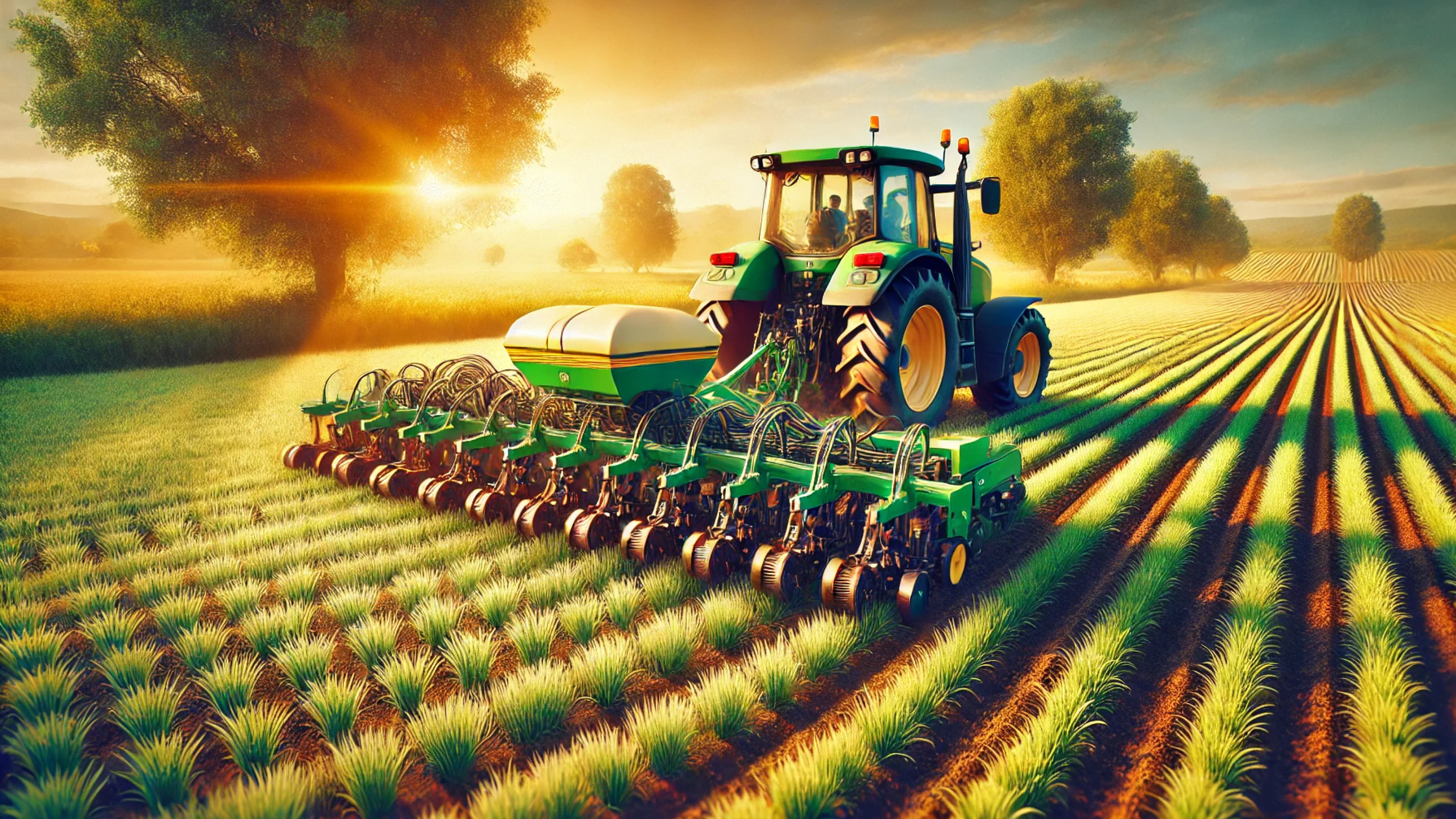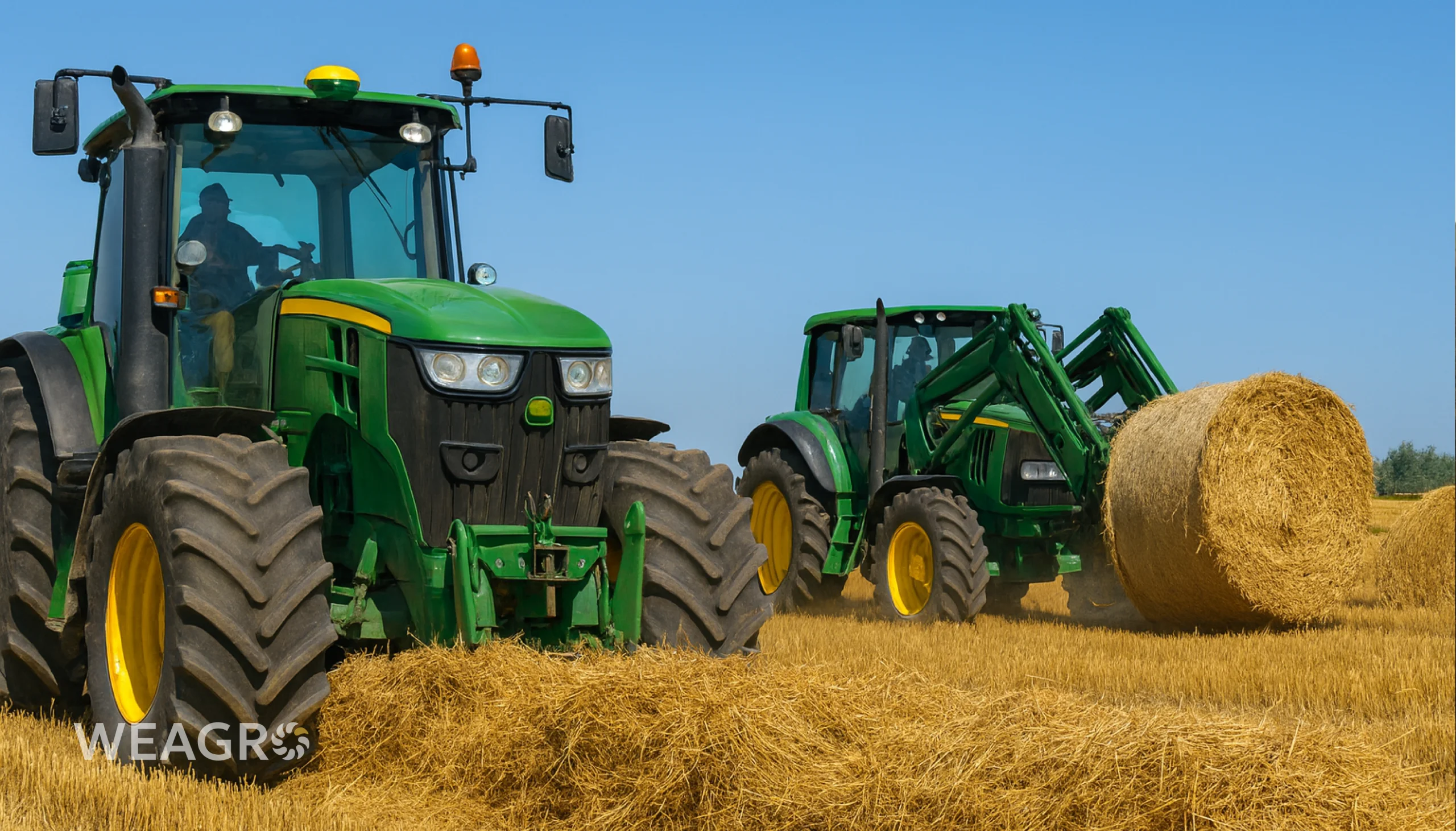Using modern equipment promotes agribusiness development: the right choice of machinery and understanding how to set the seeder’s seeding rate significantly improves current results. This ensures efficient and uniform seeding, as well as precise depth control. The result: rational resource use and high productivity. This solution is relevant for both large agricultural enterprises and small farms, consistently ensuring high levels of productivity and economic efficiency.
What is a Seeder
A special category of agricultural equipment has been developed for automated seed sowing. A seeder is equipment designed for precise and controlled distribution of seeds for almost all plant crops on pre-prepared soil. Thanks to the uniform placement of planting materials at a specific depth and distance, it’s possible to increase not only the efficiency of field sowing but also the final yield. The basic construction consists of the following components:
- seed hopper:
- harrow coulter;
- seed feeding mechanism;
- elements that level the soil after completion of the process.
The models available for sale can differ in functionality and operational characteristics, giving farmers the opportunity to choose a relevant option considering the conditions of its further use. Some units are equipped with multiple sets of identical tools, allowing simultaneous processing of several areas, significantly increasing work productivity.
Read also: Soil: What It Is, Types, and Its Fertility
Classification of Seeders
First, it’s necessary to determine the purpose of purchasing the equipment and consider the characteristics of the planting material for which it is intended. A seeder is indispensable equipment in the agricultural sector. For processing large fields, tractor models are used, which come in two variants:
- trailed – optimal for tractors up to 60 hp;
- mounted – require agricultural machinery capable of providing 200-220 hp.
Units are also distinguished by other criteria, which simplifies the selection of an appropriate series.
By Seeding Method
Depending on the peculiarities of planting material distribution, the classification of seeders includes the following categories of units:
- Row seeders – perfectly even rows where seeds are sown at the same depth. You can set both standard row width format ranging from 10 to 25 cm, and narrow – up to 10. And for band seeding, the spacing is reduced to 3-10 cm.
- Broadcast seeders – a popular option for quick grass seeding, which involves distributing seeds on the surface of a given area.
- Nest seeders – perform simultaneous seeding of several parallel rows.
- Precision seeders – an alternative to row seeders, which is more functional.
First of all, it’s necessary to determine the desired seeding pattern considering the needs and growing conditions of the selected agricultural crops.
Types by Purpose
There are universal models suitable for working with practically any seeding materials. They handle both grains and oilseeds excellently, allowing them to be used for various purposes.
There are also specialized series. If the agribusiness doesn’t plan expansion in the near future and mainly focuses on specific crops, then this option should be chosen. It’s most commonly used for vegetable seeding.
By Operating Principle
There are two types of seeders that differ in their seeding method, which should be considered when purchasing:
- Pneumatic seeders – fast, with good productivity, precisely “deliver” seeds into prepared furrows using compressed air flow. A good choice for row crops and continuous seeding, suitable for distributing pelleted and calibrated seeds. They function excellently in combination with soil cultivation equipment, allowing multiple tasks to be combined.
- Mechanical seeders – less productive but can be used for any grain crops, similarly sized seeds, and grasses. The apparatus can be adjusted and calibrated for specific materials.
Manufacturers actively install electric and hydraulic drives, as well as additional electronic systems on both types of seeders. This allows adjusting the number of spool rotations based on current conditions. This will increase the accuracy of distribution and dosing of seeding materials, which will positively affect yield.
Read also: Cultivator: What It Is and How to Choose Correctly
How to Choose a Seeder
The right choice of agricultural equipment is key to successful cultivation of farming lands. And a seeder is the main unit needed at the planting stage. When buying, consider the following criteria:
- Soil cultivation technology – minimal or direct seeding, which determines the type of appropriate equipment.
- Plot area – field size determines the required equipment productivity and working width.
- Regional climate – operating conditions must be considered, as well as soil moisture and density levels.
- Mounting method – there are mounted and trailed models.
- Types of seeders – there are single-row, double-row, and other equipment variations, and the choice between them depends on the type of crops being planted.
It’s important to choose a model that perfectly matches the given conditions and farm needs. And the online service WEAGRO opens unique opportunities for farmers: purchase with deferred payment is available, allowing them to be fully equipped for future planting work.
How to Properly Set up a Seeder
After determining the model that meets the farm’s needs, it’s necessary to establish key settings. This will ensure proper distribution of seeding materials. How to set the seeder to the seeding rate:
- The reducer has double gears that differ in size. If one of them is fixed in a static position, the other will rotate freely. This allows changing sowing volumes, doubling them.
- Most models have a special handle that allows adjusting the amount of seeding material. Based on the size and characteristics of the crop being distributed, its settings can be changed.
- For calibration and setting the required number of rotations, disconnect the seed tubes, placing a tray under them. After rotating the main shaft, the monitor will display the number of rotations. Weighing the seeding material at the final stage allows evaluating the correspondence between the plan and actual indicators to make relevant adjustments.
- The permissible deviation from the norm should not exceed 1%. In case of frequent setting changes, it’s rational to use an optional electric drive, which greatly simplifies calibration and adjustment of the unit.
There are different types of seeders – and it’s important to choose models that precisely maintain the set depth. Double-disc designs are optimal, where the first component forms the furrow and the rear one cleans the seed bed.
Differences in Sowing Large and Small Seeds
The equipment is equipped with different shutters, and one of them needs to be opened depending on the parameters of the seeding materials. Thus, single-row is relevant for small seeds, three-row for large ones. This ensures gradual seed flow, which greatly increases sowing accuracy even with small volumes.
In pneumatic models, it’s easy to change spools. And in mechanical ones, each coulter has its own, which takes considerable time. Therefore, it’s better to choose universal models that combine several types of seeding.
How to Set Seeding Depth
For quick seeding, two rows of coulters are relevant, with the ability to offset rows in a wide range of sizes. A centralized option for setting furrow depth is a convenient solution. A tine harrow at the right height and angle is necessary to prevent moisture loss.
Seeder Maintenance
Manufacturers develop specific operating rules for each model, compliance with which is necessary for its stable and uninterrupted operation over a long period. Maintenance includes following these recommendations:
- Cleaning – comprehensive cleaning of seeding material residues and small debris after each use.
- Calibration – regularly check the established settings to consistently maintain the set seeding depth, inter-row distance, and other indicators.
- Maintenance – visual diagnostics allows detecting damaged elements for their timely replacement or repair.
A seeder is seasonal equipment. And during periods when it’s not in use, it’s important to choose a dry space protected from adverse weather conditions for storage. This will help maintain the equipment in good condition for successful operation over many years.
Conclusion
Quality agricultural equipment is an investment in development and future profits. A functional seeder saves time, effort, and resources, and also contributes to yield increase. A convenient online service has been developed specifically for agricultural sector representatives WEAGRO. This simplifies the interaction between sellers and buyers. With us, it’s easy to choose quality, reliable equipment that meets specified criteria. Favorable agricultural installment allows purchasing equipment before the season starts and paying gradually. Payment deferral is a great opportunity to plan expenses more effectively and purchase necessary tools and materials for work on time.









